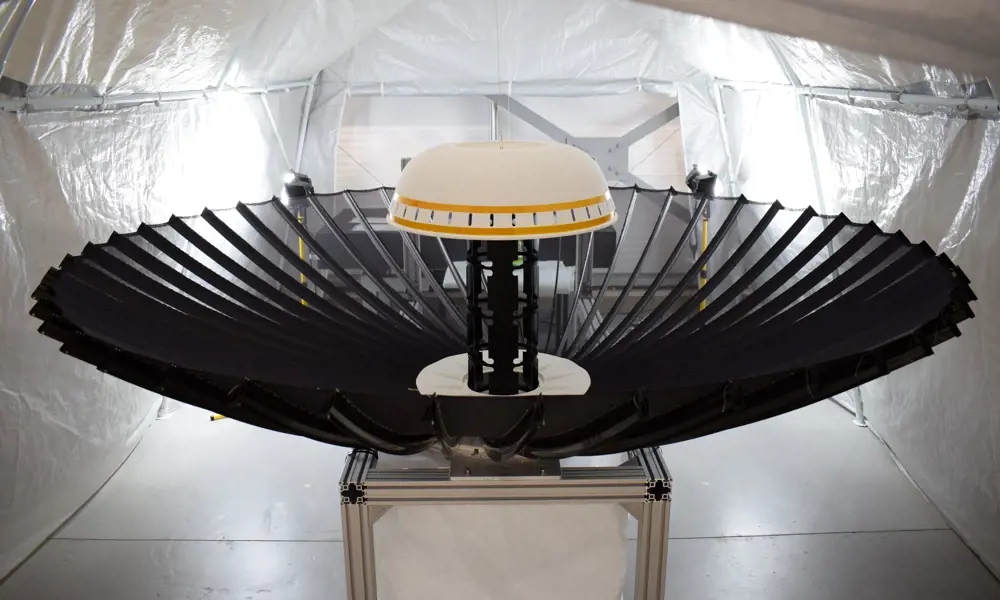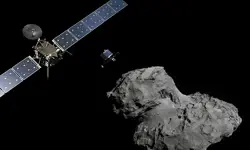
Space-saving solutions for satellites
As the Earth’s population grows, the importance of monitoring humans’ impact on the planet is ever increasing. One of the most effective ways of monitoring shipping, land use, natural disasters and climate change is from satellites.
However, getting a satellite into orbit is expensive, costing anywhere up to £50,000 per kilogram. Reducing the mass of deployable structures, such as antennas, solar panels and boom systems, can make spacecraft more cost-effective as these often make up a large percentage of the satellite’s mass. Deployable structures are used for folding key components of a satellite for transportation and storage, because the space available in a rocket is heavily constrained. Once in space, deployable structures allow the satellite to unfold and become fully functional.
Deployable structures are used for folding key components of a satellite for transportation and storage, because the space available in a rocket is heavily constrained
Novel origami-based design
Oxford Space Systems uses novel design techniques based on origami to fold and unfold its space-based antennas more efficiently. Conventional deployable parabolic antennas are complex and expensive, often using cables and pulleys to tension an antenna’s wire mesh surface. Oxford Space Systems’ ‘shape memory’ flexible antenna surface removes the need for these traditional systems. When deployed, it naturally adopts its moulded, pre-packed shape in microgravity, making it more reliable and easier to store.
Oxford Space Systems uses novel design techniques based on origami to fold and unfold its space-based antennas more efficiently
The antenna also uses unique and flight-proven materials, such as its proprietary flexible composite technology, which the company combines with conventional materials to create a new generation of lightweight deployable structures. Oxford Space Systems’ antenna structures are highly scalable, ranging from 2 metres to 15 metres in diameter.
Benefits to society
The cost and stowage efficiency of Oxford Space Systems’ antenna technology means that it can enable the development of a new generation of lower cost, more capable satellites. Lower cost satellites, for example, will provide more readily available Earth observation services at lower prices. This data is used to identify and monitor pollution, track aircraft and ships, assist with fishing protection, measure sea level and temperature, and monitor weather.
Lower cost satellites, for example, will provide more readily available Earth observation services at lower prices
One of its two successfully flown AstroTube™ booms is being used in the RemoveDebris mission (‘Mission to remove space debris’, Ingenia 72), which is testing a harpoon system to capture space junk. In the 60 years that humans have been exploring space, significant junk and pollution has accumulated in orbit. As such, space debris removal has increasingly become an active area of research and development in the UK.
Through the successful launch of the AstroTube boom, the company has also set a space industry record, with a material and product design, test and in-orbit demonstration in under 30 months.
Commercial success
Oxford Space Systems is currently a showcase NewSpace company for the UK Space Agency and Innovate UK, having received over £2 million in co-funding support from these agencies. Today, Oxford Space Systems attracts global interest and has contracts in the UK, Europe, Asia and the US, with customers ranging from universities to the largest satellite manufacturers. It works with the European Space Agency and the UK Space Agency, among others.
Two US companies currently dominate the global market for deployable space antennas, but Oxford Space Systems is positioning itself as a more cost-effective and agile UK alternative. Its recent developments have opened the global market, increasing the quality and competitiveness of antenna-enabled services such as data relay, Earth observation and telecommunication.
***
This article has been adapted from "MacRobert Award 2018: Space-saving solutions for satellites", which originally appeared in the print edition of Ingenia 75 (June 2018).
Keep up-to-date with Ingenia for free
SubscribeRelated content
Aerospace

ALMA – the high altitude observatory
The Atacama Large Millimetre/submillimetre Array (ALMA) is the largest and most expensive ground-based telescope built, revolutionising our understanding of stars and planetary systems. Building it in the Atacama Desert in Chile required the ingenuity of hundreds of engineers.

Communicating with outer space
The Royal Academy of Engineering awarded a team at BAE Systems the Major Project Award in June 2016 for their development of a powerful satellite modem system, pivotal in enabling the precise control of the pioneering Rosetta spacecraft and the first-ever soft landing of a spacecraft on a comet.

An aircraft like no other
The Airlander made headlines when it embarked on its first test flight in August 2016 as the world’s largest aircraft. Chris Daniels at Hybrid Air Vehicles Limited, and David Burns, Airlander’s Chief Test Pilot, talk about the engineering that helped it reach this stage and plans for the craft’s future.

Q&A: Lucy Harden
Lucy Harden is a mechanical engineer on BAE Systems’ Digital Light Engine Head-Up Display development programme. She devises innovative solutions for pilots to display essential flight information that sits directly in their line of sight and is overlaid onto the real world.
Other content from Ingenia
Quick read

- Environment & sustainability
- Opinion
A young engineer’s perspective on the good, the bad and the ugly of COP27

- Environment & sustainability
- Issue 95
How do we pay for net zero technologies?
Quick read

- Transport
- Mechanical
- How I got here
Electrifying trains and STEMAZING outreach

- Civil & structural
- Environment & sustainability
- Issue 95